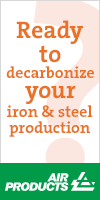MEPS International Steel Market Roundup
11/11/2004 - MEPS (International) Ltd provided the following summary of international flat steel and long products markets:
MEPS (International) Ltd provided the following summary of international flat steel and long products markets:
Real consumption of Flat Products remains healthy in the U.S., although distributor inventories are high. Service centers, concerned about holding such expensive stocks, are buying more cautiously, and all speculative purchasing has ceased. Auto manufacturers have cut back their production and it is expected that demand will be at lower levels for the balance of the year. Market conditions are then expected to pick up in the first quarter 2005. Availability from off-shore sources has improved, and domestic transaction prices have softened.
Canadian activity is subdued. Published raw material and energy surcharges are likely to go up by $C40 per ton for November. However, due to increased import offerings and price slippage in the U.S., these increases could be difficult to achieve. Tonnage is arriving from South America, Egypt, Turkey, Taiwan and Russia at values that are still about 10% under Canadian mill prices. Service centers with these products are discounting to obtain additional sales. This is normally the factor which creates the downward pricing spiral for local steel producers.
Chinese traders are still reluctant to place orders with overseas suppliers without careful consideration because international prices are so much higher than those in the domestic market. Export volumes are increasing rapidly for the same reason.
The Japanese local market is quite strong, which is helping to offset a recent fall-off in export business, particularly to South Korea and China. Imports continue to strengthen. Inventories at the docks, as of end August, increased by 4.2% compared with the previous month and by over 30% from a year earlier.
In the fourth quarter, demand from South Korean machinery manufacturers, electric home appliance makers and auto producers is predicted to rise. Relatively low local steel prices continue to keep import penetration under control.
In Taiwan, home market prices are still being driven by escalating raw material costs. MEPS foresees no significant improvement in consumption. Players are anxious about the situation in China, where — despite improvements after the long holiday — the prices that buyers can afford are not attractive.
Strip producers in the EU have pushed through their period-four price proposals. Orders placed in the last month have been settled at even higher values in several countries. Arcelor is considering raising prices in the first quarter 2005 by 3 to 7%, depending on product. Corus and ThyssenKrupp are likely to lift their figures by a similar amount. As a result, EU price levels are nearing average world market values, which could translate to an increase in imports in the near future. For the moment, offers from third country suppliers remain limited in most countries.
Polish domestic sales are improving in-line with the general economy. Import penetration is modest and price trends remain positive. The fourth quarter is sold out in the Czech and Slovak Republics. Distributors are carrying very little stock, and margins are good. End users' inventories are also low. Local producers have already announced that prices will be even higher in the next trimester, with an amount of 4 to 5% percent being quoted. Customers will have no choice but to accept the decision.
The commercial construction market for Long Products is weak in the U.S. A slide in scrap values caused several mills to lower their raw material surcharges. In some instances, this has not been offset by a similar basis price increase. Canadian building activity continues to slow. MEPS has noted some minor transaction price reductions since September.
The construction steel market in the Guangzhou region of China remains basically steady after the long holiday with only small price fluctuations. Deterioration was more marked in other areas of north and eastern China. Investment in real estate continues to slow.
The outlook is optimistic in Japan, where October/December is traditionally the best quarter for demand from civil works projects.
South Korean building output is forecast to become even more sluggish during the final trimester, partly because of deceleration in the real estate market. A continuing drop in public sector works is not helping the situation. Nevertheless, prices for most long products are higher this month, driven by escalating raw material costs. Taiwanese sales are satisfactory. MEPS detects upward price pressure for most products.
Prices have moved up in several EU countries this month, and are expected to increase further as European scrap charges are on the rise again. Although Polish demand has been strong throughout the peak summer building period, growth in construction activity is lagging behind many other sectors. Building work continues apace in Slovakia and the Czech Republic. Things are expected to slow at the turn of the year.
Source: MEPS - International Steel Review



-(220-x-200-px)-(130-x-130-px)-(220-x-200-px).jpg?lang=en-US&ext=.jpg)
Veolia.gif?width=200&height=200&mediaprotectionhash=4deca34a0d5a00013b5a0ccdc2dcf98fd2c17aabb57eb7bbb27200552f29c247&ext=.gif)





